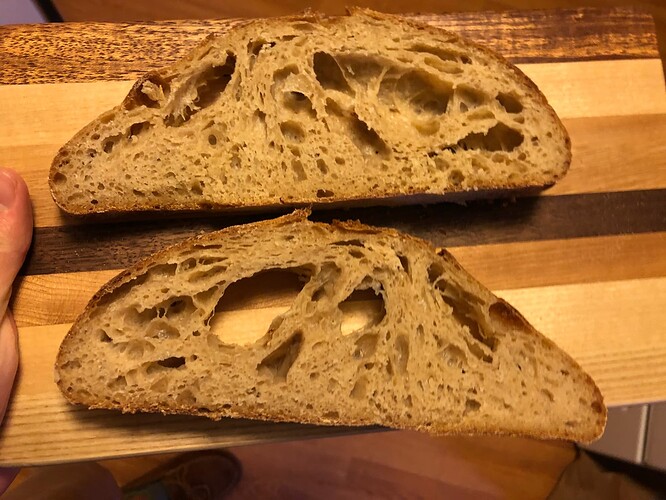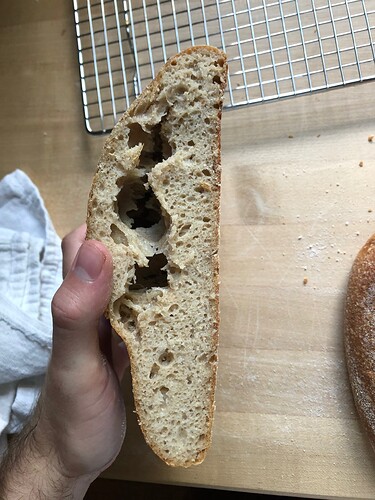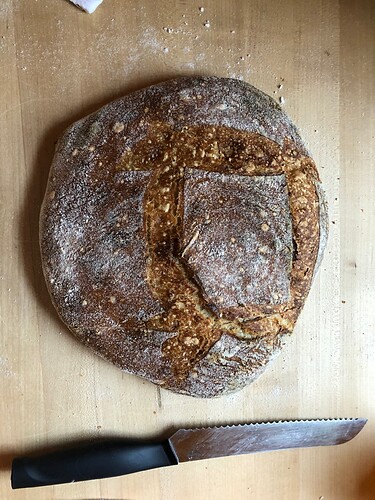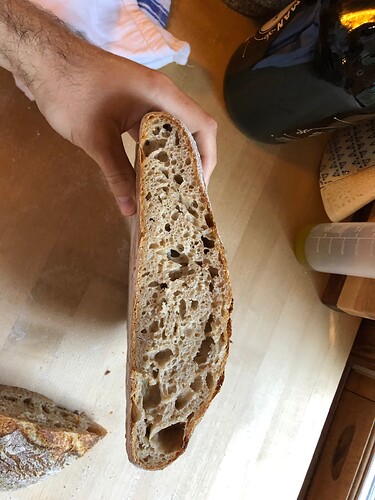Hi,
Last spring I purchased the Mockmill stand mixer attachment and began milling my own flour (at the setting where you can hear the stones just touching, milled and sifted through #40 sieve and then the course stuff re-milled until I hit 90% or so extraction), and I’ve had a lot of trouble getting a good loaf from the fresh flour, to the point where I’m close to giving up on the whole endeavor and going back to store bought flour. I’ve tried a lot of different combinations of hydration, fermentation and proofing times, and kneading/not kneading/stretch and folds, but have a few consistent problems. After the bulk ferment, even if the dough passes the windowpane test, it flattens out some (or a lot) to the pre-shape, difficult to shape or sticks to the counter, and then flattens out and has large, uneven holes which tunnel through the top of the bread and often look as if they’ve ripped. Here are some photo examples of my recent failures:
The above image was a 25% fresh milled flour (a blend of spelt, white wheat, red wheat, and rye in equal proportions) and 75% bread flour, at 80% hydration, bulk fermented in a warm room for 5-6 hours until it had grown around 30% and had bubbles throughout, then given a bench rest, shaped, and proofed until it passed the finger dent test. Baked in a cloche at 485F for 33 minutes with lid on, then 15 minutes with lid off. It turned out ok, but has the uneven holes.
The next loaf (cross-section above) followed the same process but with a slower proof (colder ambient temperature) and used 10% fresh milled rye, 10% fresh milled hard red wheat, 10% fresh milled hard white wheat, and 10% fresh milled spelt. It turned out much worse, and much more like many loaves I’ve made in the past 6 months with high amounts of fresh flour.
To see if I was under proofing, I put a second loaf from that batch into the fridge for an overnight proof (it was bulk fermented together with the previous loaf, shaped at the same time, and then put in the fridge). It looked much the same (see above), though it was slightly less dense at the bottom.
Finally, the above loaf. It was the best of them, but still flat and hard to shape. It had 189 grams of fresh milled flour (same spelt/white/red/rye mixture), 311 grams bread flour, 100g mature starter, 430 grams of water, 10 grams of salt. I mixed the flour, starter, and all but 50g of the water, then let that mixture sit for an hour in a 69F room. After an hour, I added the salt and rest of the water, mixed it in, and did stretch and folds. I continued doing stretch and folds every 30 minutes for 4 hours, until the gluten seemed well developed. I then left the dough alone to ferment until it had grown 30% or more in size and had bubbles throughout (I could see through the side of the container). I then did a pre-shape after 7.5 hours at 69 degrees F, shaped after a bench rest of 30 minutes, proofed for 3 hours and 45 minutes, and baked.
Really looking for any tips to improve, I feel like I’ve forgotten how to make bread entirely and am struggling to make good loaves. Thanks!




